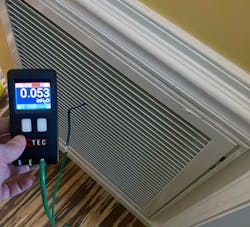Air quality continues to be a hot topic in our industry. Your customers are more aware of the air they breathe than ever before. They also want the best filtration on the market to protect their loved ones and are doing more research than ever before. This research often leads them to a filter that looks good on paper but could have unintended consequences for their HVAC system.
There’s much more to filtration than just the marketing hype. Design and installation are critical ingredients for an air filter to perform as intended. Let’s look at four installation defects that kill air filter performance and reduce their effectiveness.
1. Poor Filter Rack Design and Installation
One common issue that kills air filter performance is the design and installation of the filter rack. Poorly fitting racks with inadequate seals allow unfiltered air to move around the filter instead of through it.
As you examine the systems, you maintain and service, it’s common to discover gaps that could pull a cat through. When installed at the air-handling equipment, this bypass and leakage often result in dirt accumulating on the blower wheel, indoor coil, and secondary heat exchanger. A visual inspection and attention to detail are typically all you need to reveal this issue.
It’s important to remember the building connects to the HVAC system and could have as much, if not more, influence on the air quality problems you deal with.
If the filter is the correct size, the repair is minor – you’ll need sheet metal, gaskets, and silicone. If the filter is undersized, repairs are more involved. Many contractors will offer upgrades that include a sealed rack with a properly sized filter.
2. Filter Grilles and Duct Leakage
When an air filter is in a remote return grille, there are two sources of reduced filtration - the grille itself and return duct leakage. If you’ve ever heard a filter move back and forth in the grille as the blower turns on and off, you’ve encountered a poorly fitting filter grille.
As you probably know, air takes the path of least resistance. Remember that dirt travels along with it. Poorly fitting filter grilles result in unfiltered air moving into thesystem. You’ll often notice this as dust streaking on the exiting airside of the filter.
Duct leakage isn’t as obvious a problem unless you dig deeper. Pressure in a system increases as you get closer to the blower. This means duct leakage increases near the air-handling equipment. Any unsealed penetrations in the return duct between the filter and equipment allow unfiltered air to enter the duct system. This air is from attics, crawl spaces, or garages, and it’s air you don’t want to breathe.
You can correct this with gasket material at the filter grille and targeted sealing of the return ducts. Before you perform this work, be sure the filter grille and return ducts are the correct sizes.
3. Excessive Filter Face Velocity
The next problem can appear even with a perfectly sealed filter rack and duct system. Excessive face velocity pulls particulate through the filter media instead of capturing it. You will typically encounter this when the media is undersized for the volume of air it filters.
Each filter media type has a specific airspeed range to operate within effectively. When airspeed exceeds this range, the filter cannot capture particulate.
Sizing is one reason pleated and electrostatic filters have such a poor reputation. It isn’t the filter media itself; the size is the problem. Each filter media type has a specific airspeed range to operate within effectively. When airspeed exceeds this range, the filter cannot capture particulate. Instead, it pulls through or around the media. Then, it accumulates inside the air-handling equipment or moves through the duct system.
It requires a bit of design work to correct this issue. Email me for a free procedure if you’re interested in learning more about how to size an air filter.
4. Air Handler Cabinet Leakage
Filter access panels, electrical penetrations, and cabinet leakage allow unfiltered air to move around the filter and introduce pollutants into the duct system. In recent years, equipment manufacturers have done a better job of reducing cabinet leakage. However, there is still a lot of equipment out there that needs your help.
This problem is like poor filter rack design. You can correct it using similar principles. You will use more silicone and gasket material to reduce cabinet leakage and ensure air passes through the filter. Attention to minor details can reap big rewards when solving this issue.
Remember, if you decide to reduce cabinet leakage, you must seal the panels in a manner that allows for access to the equipment later. Think twice about using mastic to accomplish this task. The service department will hunt you down if they have to chisel it off the panels.
Look Beyond the Equipment
Don’t forget to consider other particulates from exterior sources that may never even make it to the air filter. These include insulation fibers, pet dander, and vacuum cleaners that blow as much back into the room as it picks up.
It’s important to remember the building connects to the HVAC system and could have as much, if not more, influence on the air quality problems you deal with.
David Richardson serves the HVAC industry as director of training for National Comfort Institute, Inc. (NCI). NCI specializes in training that focuses on improving, measuring, and verifying HVAC and Building Performance.
If you’re an HVAC contractor or technician interested in a free filter sizing procedure, contact David at ncilink.com/ContactMe or call 800-633-7058. NCI’s website www.nationalcomfortinstitute.com is full of free technical articles and downloads to help you improve your professionalism and strengthen your company.










